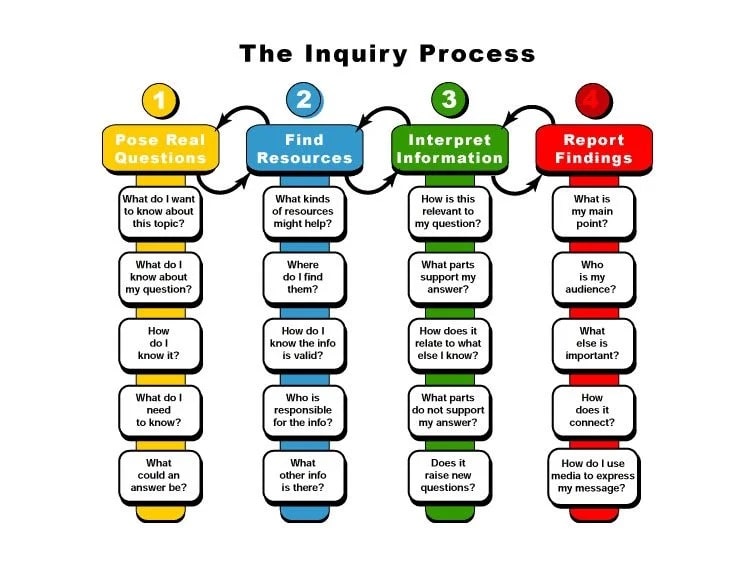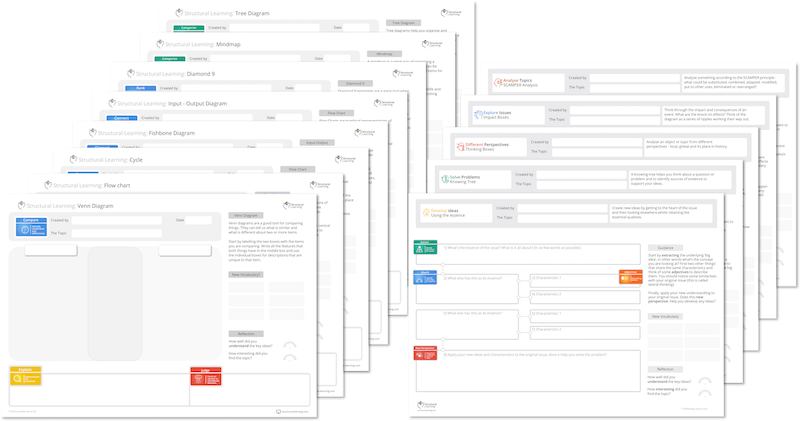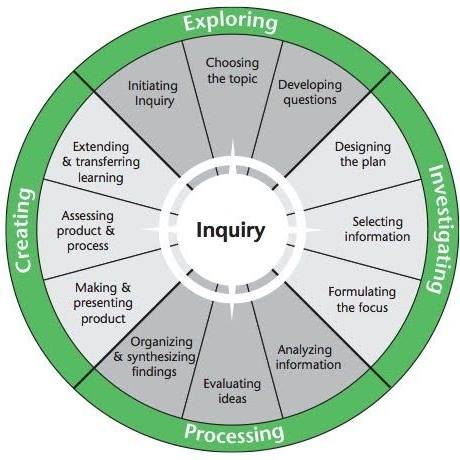Inquiry-Based Learning: A Complete Guide for Teachers
Master inquiry-based learning with practical strategies for implementation. Understand how to design inquiries, scaffold student investigation, and develop genuine curiosity in learners.


Master inquiry-based learning with practical strategies for implementation. Understand how to design inquiries, scaffold student investigation, and develop genuine curiosity in learners.
Inquiry-based learning is a process of learning that engages learners by creating real-world connections through high-level questioning and exploration. The inquiry-based learning approach encourages learners to engage in experiential learning and problem-based learning.
Inquiry-based learning is about triggering curiosity in students and initiating a student’s curiosity achieves far more complex goals than information delivery. Despite its complex nature, inquiry-based learning is considered easier for teachers because it does not only shift responsibility from the educators to students, but also it is engaging for students.
Inquiry-based learning is important for creating excitement in students. It motivates students to become specialists of their learning process. However, this type of learning requires a certain level of independent learning skills. Children need to have developed the information-processing skills needed for working with minimal guidance. In this article, we will argue that there is a place for this type of learning but it does need to be supported with appropriate teacher training and balanced with more traditional curriculum delivery.
Inquiry-based learning puts the student at the center of the learning process. Instead of simply absorbing information, students are encouraged to explore and discover knowledge on their own. This approach allows students to develop critical thinking and problem-solving skills, as well as a deeper understanding of the subject matter. The learning process becomes more engaging and meaningful, as students take ownership of their education and develop a sense of curiosity and wonder. However, it's important to remember that inquiry-based learning is just one approach to education and should be balanced with other teaching methods to ensure a well-rounded education.
Teachers can apply inquiry-based instruction in many ways, but some of its basic components include:
The inquiry-based structure of learning has a lot of flexibility. Teachers frequently begin from inquiry-based science lessons, but the inquiry-based approach can be implemented into student learning to any lesson and subject. These transferable skills can be used to help pupils become more effective learners in the long run. In higher education, students are required to manage their own time and do their own research. This approach to teaching is a way of building skills for the long term.

In a world history class, the COVID-19 pandemic can be used to compare, study and examine the history of pandemics. A group inquiry lesson may have the following components:

Inquiry-based teaching strategies also support Science teacher while encouraging students to think deeper in Science lessons. Learners may brainstorm questions of their interest and discuss topics that amuse them.

Inquiry-based learning transforms the traditional classroom dynamic, engaging students in a more meaningful and interactive learning process. This method has several key benefits:
By adopting inquiry-based learning, educators can create a dynamic classroom environment that not only addresses academic standards but also prepares students for the complexities of the real world.

Inquiry-based learning works by engaging students through high-level questioning and real-world problem exploration, shifting from teacher-led instruction to student-driven discovery. Teachers guide students through a five-stage framework from observation to discussion, providing scaffolding and continuous support as students develop independent learning skills. The process requires pre-teaching essential skills and structured group work to ensure all students can participate effectively in their investigations.
Incorporating inquiry-based learning into your classroom might seem daunting, yet it holds immense potential for fostering deep learning and enhancing conceptual understanding. Let's break it down into practical steps that can be seamlessly integrated into your classroom practice.

According to a study by the Education Endowment Foundation, students engaging in inquiry-based learning showed a positive impact equivalent to an additional three months' progress.
Professor John Hattie asserts, “Inquiry learning requires teachers to be aware of how to prompt deep thinking, to be conversant with multiple ways of knowing and presenting information, and to be skilled at providing multiple opportunities for students to engage with substantive and syntactic knowledge of the subject.”
Successfully implementing inquiry-based learning may take time and practice, but the payoff in terms of student engagement and learning outcomes makes it a journey well worth undertaking.
Teachers should understand that inquiry-based learning requires more initial support and scaffolding than traditional teaching methods, despite ultimately building greater student independence. Success depends on balancing student exploration with explicit skill-building and maintaining continuous observation-based assessment rather than relying solely on written tests. The approach works best when teachers receive proper training and combine inquiry methods with traditional curriculum delivery for optimal learning outcomes.
Inquiry-Based Teaching Methods provide an exciting way to learn and teach. However, teacher professional development and training are important, not only for inquiry-based learning but also for student success. To create engaged and meaningful learning experiences in a classroom, schools must provide teacher training opportunities to teachers to teach these inquiry-based lessons successfully.
Schools need to build time into the curriculum for these types of autonomous exercises as they are essential life skills. However, not all subject material is appropriate for this sort of approach to education. Pupils will need to have the learning skills and cognitive attributes to run with these methods.
There will always be a body of knowledge that just needs to be taught from the front, picking the topics suitable for this type of approach is half the battle. If a student is not well practised or confident in the area of independent learning then they may develop knowledge gaps that hinder their learning.

Teachers can access professional development courses, research-based frameworks, and practical implementation guides that detail the five-stage inquiry cycle and assessment strategies. Key resources include materials on scaffolding techniques, pre-teaching strategies, and methods for transforming chaotic group work into structured investigations. Online communities and case studies from successful inquiry-based classrooms provide real-world examples and ongoing support for implementation.
Here are five key studies on the efficacy of inquiry-based learning and its impact on student outcomes:
These studies collectively emphasize the positive impact of inquiry-based learning on various student outcomes, including motivation, self-efficacy, academic performance, and the development of critical thinking and problem-solving skills.
Inquiry-based learning is a process that engages learners by creating real-world connections through high-level questioning and exploration, putting students at the centre of the learning process. Unlike traditional methods where students passively absorb information, this approach encourages students to explore and discover knowledge independently whilst developing critical thinking and problem-solving skills. The teacher's role shifts from director to facilitator, allowing students to take ownership of their educational journey.
The five components are: Observation/Orientation (introducing concepts through hands-on activities), Conceptualise/Question (students generate questions and hypotheses), Investigation (the longest phase where students research with teacher support), Conclusion (drawing conclusions from collected data), and Discussion (sharing findings and learning from peers). This flexible structure can be adapted to any subject and helps build transferable skills that prepare students for higher education and independent learning.
Teachers can use current events to connect with historical topics, such as comparing the COVID-19 pandemic with the 1918 Spanish Influenza through video clips and group discussions. Students work in smaller groups to generate deeper questions, use resources like historical databases and libraries for research, then present their findings to the class whilst the teacher facilitates discussions and provides scaffolding support.
Students need to have developed information-processing skills and a certain level of independent learning capabilities to work effectively with minimal guidance. The article emphasises that inquiry-based learning requires explicit skill-building and pre-teaching strategies rather than simply assigning discovery tasks. Teachers must provide appropriate scaffolding and support to help students develop genuine self-directed learning abilities.
Inquiry-based learning enhances critical thinking and problem-solving skills whilst moving students beyond passive note-taking to active investigation. It stimulates curiosity, develops communication abilities, and helps students achieve deeper understanding through making connections rather than rote memorisation. This approach increases engagement, fosters ownership of learning, and can lead to higher achievement in standardised tests and greater school completion rates.
The article argues that inquiry-based learning should be balanced with more traditional teaching methods to ensure a well-rounded education, supported by appropriate teacher training. Teachers need to provide explicit skill-building and scaffolding rather than simply shifting all responsibility to students. This approach works best when combined with direct instruction and structured support to help students develop the independence needed for successful inquiry-based work.
The article mentions an 'assessment revolution' where continuous observation during inquiry replaces traditional marking marathons and reveals deeper understanding than written tests. Teachers can supervise inquiry activities, facilitate discussions, correct mistakes, and present further questions during the process. This ongoing assessment approach provides more meaningful insights into student learning than conventional testing methods.
Inquiry-based learning is a process of learning that engages learners by creating real-world connections through high-level questioning and exploration. The inquiry-based learning approach encourages learners to engage in experiential learning and problem-based learning.
Inquiry-based learning is about triggering curiosity in students and initiating a student’s curiosity achieves far more complex goals than information delivery. Despite its complex nature, inquiry-based learning is considered easier for teachers because it does not only shift responsibility from the educators to students, but also it is engaging for students.
Inquiry-based learning is important for creating excitement in students. It motivates students to become specialists of their learning process. However, this type of learning requires a certain level of independent learning skills. Children need to have developed the information-processing skills needed for working with minimal guidance. In this article, we will argue that there is a place for this type of learning but it does need to be supported with appropriate teacher training and balanced with more traditional curriculum delivery.
Inquiry-based learning puts the student at the center of the learning process. Instead of simply absorbing information, students are encouraged to explore and discover knowledge on their own. This approach allows students to develop critical thinking and problem-solving skills, as well as a deeper understanding of the subject matter. The learning process becomes more engaging and meaningful, as students take ownership of their education and develop a sense of curiosity and wonder. However, it's important to remember that inquiry-based learning is just one approach to education and should be balanced with other teaching methods to ensure a well-rounded education.
Teachers can apply inquiry-based instruction in many ways, but some of its basic components include:
The inquiry-based structure of learning has a lot of flexibility. Teachers frequently begin from inquiry-based science lessons, but the inquiry-based approach can be implemented into student learning to any lesson and subject. These transferable skills can be used to help pupils become more effective learners in the long run. In higher education, students are required to manage their own time and do their own research. This approach to teaching is a way of building skills for the long term.

In a world history class, the COVID-19 pandemic can be used to compare, study and examine the history of pandemics. A group inquiry lesson may have the following components:

Inquiry-based teaching strategies also support Science teacher while encouraging students to think deeper in Science lessons. Learners may brainstorm questions of their interest and discuss topics that amuse them.

Inquiry-based learning transforms the traditional classroom dynamic, engaging students in a more meaningful and interactive learning process. This method has several key benefits:
By adopting inquiry-based learning, educators can create a dynamic classroom environment that not only addresses academic standards but also prepares students for the complexities of the real world.

Inquiry-based learning works by engaging students through high-level questioning and real-world problem exploration, shifting from teacher-led instruction to student-driven discovery. Teachers guide students through a five-stage framework from observation to discussion, providing scaffolding and continuous support as students develop independent learning skills. The process requires pre-teaching essential skills and structured group work to ensure all students can participate effectively in their investigations.
Incorporating inquiry-based learning into your classroom might seem daunting, yet it holds immense potential for fostering deep learning and enhancing conceptual understanding. Let's break it down into practical steps that can be seamlessly integrated into your classroom practice.

According to a study by the Education Endowment Foundation, students engaging in inquiry-based learning showed a positive impact equivalent to an additional three months' progress.
Professor John Hattie asserts, “Inquiry learning requires teachers to be aware of how to prompt deep thinking, to be conversant with multiple ways of knowing and presenting information, and to be skilled at providing multiple opportunities for students to engage with substantive and syntactic knowledge of the subject.”
Successfully implementing inquiry-based learning may take time and practice, but the payoff in terms of student engagement and learning outcomes makes it a journey well worth undertaking.
Teachers should understand that inquiry-based learning requires more initial support and scaffolding than traditional teaching methods, despite ultimately building greater student independence. Success depends on balancing student exploration with explicit skill-building and maintaining continuous observation-based assessment rather than relying solely on written tests. The approach works best when teachers receive proper training and combine inquiry methods with traditional curriculum delivery for optimal learning outcomes.
Inquiry-Based Teaching Methods provide an exciting way to learn and teach. However, teacher professional development and training are important, not only for inquiry-based learning but also for student success. To create engaged and meaningful learning experiences in a classroom, schools must provide teacher training opportunities to teachers to teach these inquiry-based lessons successfully.
Schools need to build time into the curriculum for these types of autonomous exercises as they are essential life skills. However, not all subject material is appropriate for this sort of approach to education. Pupils will need to have the learning skills and cognitive attributes to run with these methods.
There will always be a body of knowledge that just needs to be taught from the front, picking the topics suitable for this type of approach is half the battle. If a student is not well practised or confident in the area of independent learning then they may develop knowledge gaps that hinder their learning.

Teachers can access professional development courses, research-based frameworks, and practical implementation guides that detail the five-stage inquiry cycle and assessment strategies. Key resources include materials on scaffolding techniques, pre-teaching strategies, and methods for transforming chaotic group work into structured investigations. Online communities and case studies from successful inquiry-based classrooms provide real-world examples and ongoing support for implementation.
Here are five key studies on the efficacy of inquiry-based learning and its impact on student outcomes:
These studies collectively emphasize the positive impact of inquiry-based learning on various student outcomes, including motivation, self-efficacy, academic performance, and the development of critical thinking and problem-solving skills.
Inquiry-based learning is a process that engages learners by creating real-world connections through high-level questioning and exploration, putting students at the centre of the learning process. Unlike traditional methods where students passively absorb information, this approach encourages students to explore and discover knowledge independently whilst developing critical thinking and problem-solving skills. The teacher's role shifts from director to facilitator, allowing students to take ownership of their educational journey.
The five components are: Observation/Orientation (introducing concepts through hands-on activities), Conceptualise/Question (students generate questions and hypotheses), Investigation (the longest phase where students research with teacher support), Conclusion (drawing conclusions from collected data), and Discussion (sharing findings and learning from peers). This flexible structure can be adapted to any subject and helps build transferable skills that prepare students for higher education and independent learning.
Teachers can use current events to connect with historical topics, such as comparing the COVID-19 pandemic with the 1918 Spanish Influenza through video clips and group discussions. Students work in smaller groups to generate deeper questions, use resources like historical databases and libraries for research, then present their findings to the class whilst the teacher facilitates discussions and provides scaffolding support.
Students need to have developed information-processing skills and a certain level of independent learning capabilities to work effectively with minimal guidance. The article emphasises that inquiry-based learning requires explicit skill-building and pre-teaching strategies rather than simply assigning discovery tasks. Teachers must provide appropriate scaffolding and support to help students develop genuine self-directed learning abilities.
Inquiry-based learning enhances critical thinking and problem-solving skills whilst moving students beyond passive note-taking to active investigation. It stimulates curiosity, develops communication abilities, and helps students achieve deeper understanding through making connections rather than rote memorisation. This approach increases engagement, fosters ownership of learning, and can lead to higher achievement in standardised tests and greater school completion rates.
The article argues that inquiry-based learning should be balanced with more traditional teaching methods to ensure a well-rounded education, supported by appropriate teacher training. Teachers need to provide explicit skill-building and scaffolding rather than simply shifting all responsibility to students. This approach works best when combined with direct instruction and structured support to help students develop the independence needed for successful inquiry-based work.
The article mentions an 'assessment revolution' where continuous observation during inquiry replaces traditional marking marathons and reveals deeper understanding than written tests. Teachers can supervise inquiry activities, facilitate discussions, correct mistakes, and present further questions during the process. This ongoing assessment approach provides more meaningful insights into student learning than conventional testing methods.